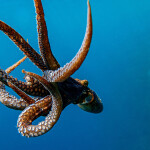Cheap cameras, low-cost sensors, further-reaching data transmission networks and rapidly improving artificial intelligence algorithms have the potential to both reduce the cost of catch monitoring and increase profitability for fishermen.
It’s a new world of fishing that the Environmental Defense Fund is pursuing with its Smart Boat Initiative, first announced in March 2019. The initiative aims to benefit both fish and fishermen by leveraging technology to document activities on deck, gather data about oceanographic conditions, and connect fishermen with buyers – even while they’re still on the water.
While the hardware – cameras and sensors – is ubiquitous and available, some of the greatest advances will come from improved machine learning algorithms that process data and cellular networks that transmit it.
Pilot programs across the United States and around the world show the promise of these new technologies, even though the fishing industry has significant catching up to do compared to other business sectors.
“Fisheries have been largely left behind in this digital revolution,” Katie Westfall, who works on fisheries advocacy at EDF, said during a webinar about the Smart Boat Initiative on 22 August.
As an example, Westfall described how various technologies could benefit a West Coast trawler setting off before the break of dawn.
The captain, as he leaves the dock, consults a map drawn from oceanographic data that guides him away from bycatch hotspots and toward promising fishing grounds. As the trawl moves along, the captain watches a net camera to monitor the fish coming into the net. Fish hauled in are then sent through a chute with another camera in it that uses computer vision to determine the length, weight and species of each individual.
This data is transmitted to fishery managers, and the catch is automatically subtracted from the quota. The captain uses another app on his phone to coordinate with buyers about what he’s caught — and potentially to sell the fish even before he’s arrived back at dock.
Meanwhile, information from the trip is streamed to a local grocery store counter to spur demand among consumers. Back at dock, data about sea surface temperature, water salinity and other ocean conditions is sent to scientists who can use it for research. The captain receives a report of his deducted quota and his balance for the season.
All this technology will benefit fishermen most if it can lower costs, according to fisherman Brad Pettinger, who headed the Oregon Trawl Commission for 15 years and has long been active in the West Coast groundfish fishery.
A human observer in the West Coast groundfish fishery can cost USD 500 (EUR 450.3) per day, adding up to USD 2,000 (EUR 1,801) over the course of a multi-day trip. Electronic monitoring could lower that cost, while even allowing fishermen to leave dock whenever they want, rather than waiting for observers.
“We’re trying to get those fees down and electronic monitoring is a great way to do that. It’s not for everyone. It’s more conducive for some fisheries than others,” Pettinger told SeafoodSource. “It’s all about cost. It’s hard to get full accountability and cheap.”
Interest in electronic monitoring has been driven by fisheries that are on a catch share system in which documentation of catch is required, according to Brett Alger, electronic technologies coordinator at the National Oceanic and Atmospheric Administration.
“There are a lot of fisheries with very low observer coverage or requirements. So those carrots aren’t there, or sticks, to drive people to electronic monitoring,” Alger told SeafoodSource. But, “it’s not always faster and it’s not always cheaper,” Alger added.
Hardware for electronic monitoring – the cameras and sensors – is cheap and accessible, and it’s easy enough to take video aboard a vessel, then give it to a human observer to watch later. The true cutting edge is developing artificial intelligence algorithms that can watch the video instead of people.
But it’s not as simple as writing a few lines of code. The AI has to be trained to correctly identify what is happening in the video. That training requires a large library of relevant, accurately tagged images. To be taught to pick a certain species of fish out from a line up, the algorithm has to be shown that fish many times over. Building those libraries will the take time and resources.
“In order to do a lot of the AI work in this space, you need thousands or tens of thousands of images that area annotated,” Alger said.
Photo courtesy of Leslie von Pless/EDF







